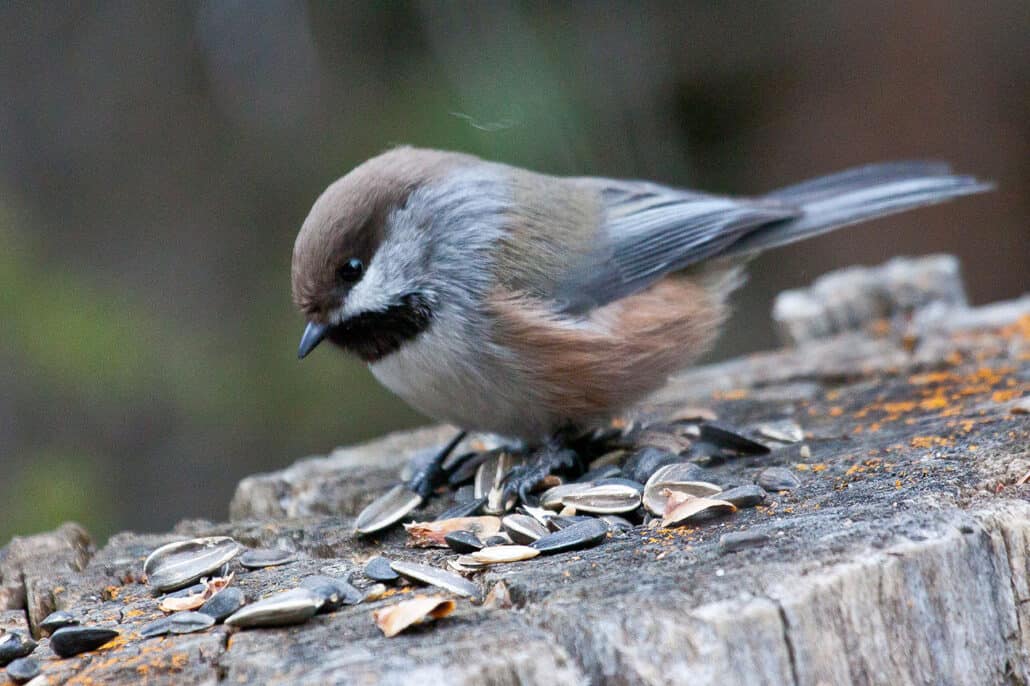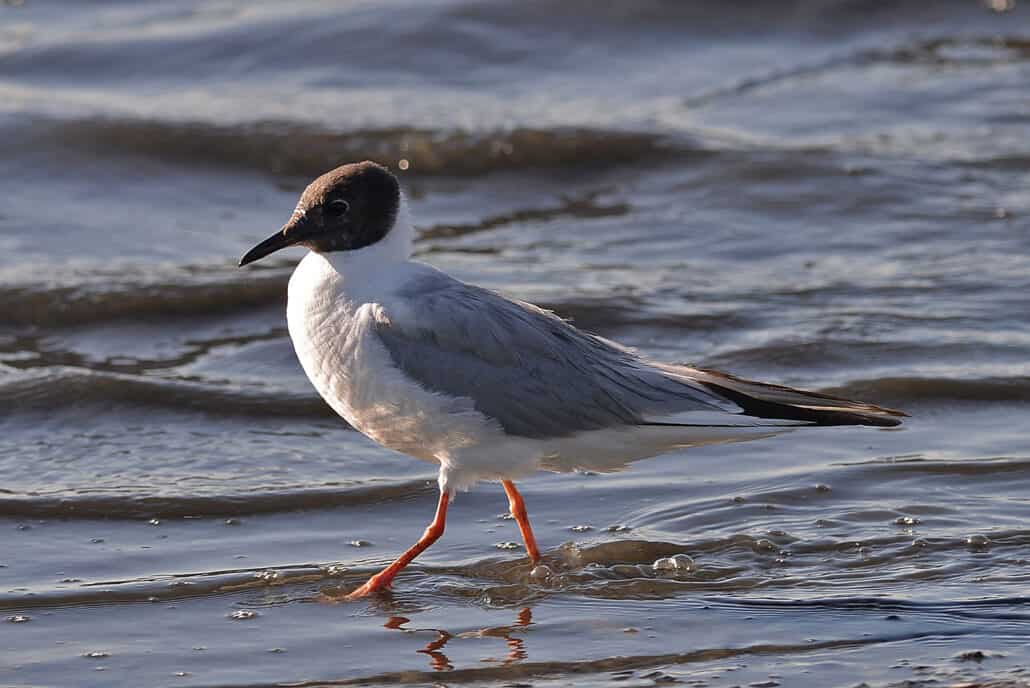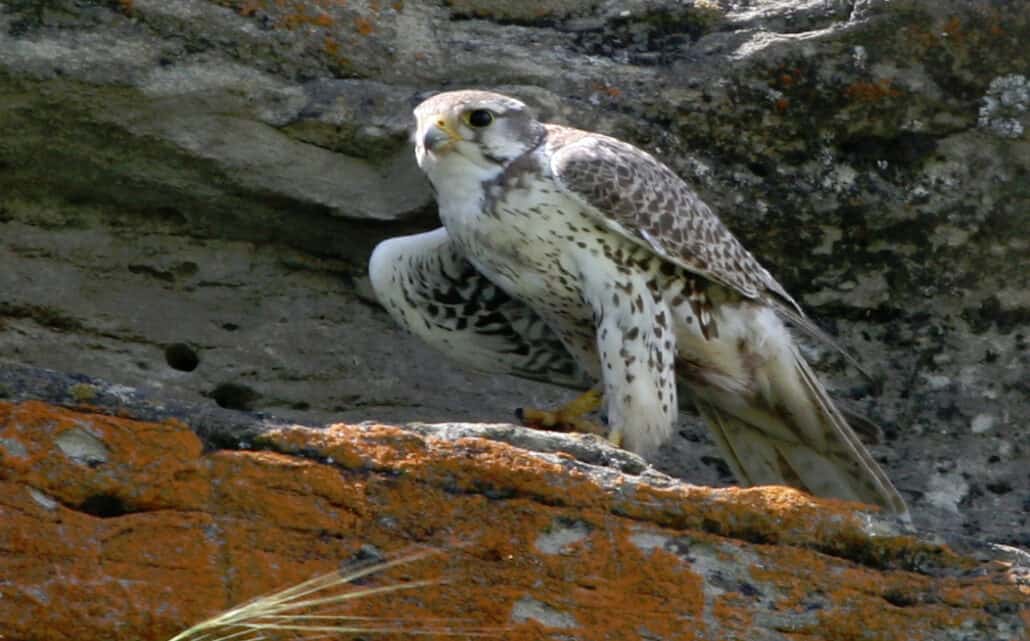Although many geologists divide Virginia into five provinces, for ornithological purposes usually three regions are designated: Coastal Plain, Piedmont, and Mountains (geologists often consider the Blue Ridge, Ridge and Valley, and Appalachian Plateau provinces separately).
Coastal Plain
The Coastal Plain, composed primarily of unconsolidated rock and newer sediments, stretches from the Atlantic Ocean west to the Fall Line. If it were possible to step back 18,000 years in time, this would be a vastly different area. At that point in geologic history much of North America was under ice, and although glaciers never advanced as far south as Virginia, they exerted a dramatic influence on topography. During the last Ice Age an observer standing at what today is Virginia Beach would not have been able to see the ocean. With large quantities of water tied up in ice, sea level was much lower and the coastline was nearly 40 miles to the east. What is now the Chesapeake Bay was the broad valley of the Susquehanna River.
As the glaciers retreated, sea level rose rapidly, and the fluctuating water carried sand forward to form our present-day beaches. The Virginia coastline is still dynamic, influenced by hurricanes, ocean currents, strong northeasterly storms, and tidal forces. Only 70 years ago Broadwater was a thriving village on Hog Island, one of the barrier islands of the Eastern Shore. Today the Atlantic Ocean has reclaimed the site.
The barrier beaches, most of which are undeveloped, are home to a variety of gulls, terns, and shorebirds. Black skimmers, the largest and most flamboyant member of the tern group, scrape their nest sites along the open sand. The endangered piping plover also uses this habitat. The spring migration brings thousands of shorebirds, pausing for a brief stop before heading north to their breeding grounds near the Arctic Circle.
Visitors to the beach probably notice the gulls first. The year-around resident great black-backed and herring gulls are well known for perching on the light fixtures along the Chesapeake Bay Bridge Tunnel. The raucous cries of laughing gulls are probably one of the most familiar summer sounds over the coastline of Virginia. Although present in small numbers throughout the year, ring-billed gulls are one of the more common species during the winter.
Herons, egrets, and ibis use the scrubby myrtle thickets to raise their young, and brown-headed nuthatches forage in the tall pines. At First Landing State Park in Virginia Beach, live oaks border the beaches, and a walk through the maritime forest community can yield a variety of warblers and several species of woodpeckers.
Slightly to the west, in Suffolk, the Great Dismal Swamp National Wildlife Refuge is the site of Lake Drummond, one of only two natural lakes in Virginia. George Washington owned large tracts there in the late 1700s and supervised the construction of some of the drainage ditches. Fortunately for us, the drainage efforts were unsuccessful and today this 106,000 acre refuge supports one of the most beautiful swamplands in the East. Some of the cypress trees are believed to be more than 1,000 years old. It is one of the few places in eastern Virginia where black bears are common. Nearly 100 bird species are known to breed on the refuge, including the elusive Swainson’s warbler.
Moving west across the coastal plain, loblolly pines become the dominant species. Much of this area is used for wood production or agricultural purposes. One of the last toe-holds of the red-cockaded woodpecker in Virginia is in Sussex County. These birds, more common to the south, drill nest holes in living pine trees and require a relatively large foraging area. Efforts are underway in Virginia to reintroduce this species.
Piedmont
The fall line separates the relatively newer geologic formations of the Coastal Plain from the deeply weathered, rolling hills of the Piedmont. During the Colonial period it represented the upstream limit for ocean-going ships. A number of cities, including Richmond, Petersburg, and Fredericksburg grew up along this point where rapids made westward navigation difficult. Interstate 95 actually follows much of this economic and geologic boundary pretty closely.
Pines give way to deciduous forests dominated by oak, hickory, tulip poplar, and beech. Tall sycamores often line the riverbanks. Birdlife in the Richmond city parks is varied and a walk during spring may produce prothonotary, hooded, and yellow-throated warblers. Double-crested cormorants can be found on the James River and terns are seen during migration.
The Piedmont, from the Latin meaning “ foothills”, stretches from the fall line to the eastern flank of the Blue Ridge Mountains. Somewhat triangular in shape, the region narrows to the north and widens across the relatively flat terrain of the Virginia Southside. Most of the bedrock is buried under the accumulation of sediments as a result of eons of erosion. The majority of the land has been in agricultural use since colonial times.
The southern Piedmont, in the vicinity of Danville and South Boston, is a good spot to find the summer tanager. Loggerhead shrikes were once fairly common in the area around Farmville, but over recent years the population has declined sharply. Toward the central area of the state, Charlottesville is representative of Piedmont habitat. The Rivanna River Trail system surrounding the city is a good place to look for both black-throated blue and black-throated green warblers. Indigo buntings and blue grosbeaks are common in weedy, overgrown fields. Toward the northern part of Virginia, in Fauquier County, Baltimore orioles become more common.
Mountains
At the western boundary the Blue Ridge Mountains mark the end of the Piedmont. Geologically complex, the Mountain Region is considered part of the Appalachian system but the underlying bedrock differs sharply from one place to another. Many of the ridges of the Shenandoah are formed of sandstone bordered by limestone valleys and caverns are scattered throughout this area. Farther south, granite is predominant along the Blue Ridge.
Just to the west of Blacksburg the paradoxically named New River meanders northwest toward West Virginia, where it joins the Gauley to form the Kanawha River. A fragment of what was probably once a great river system prior to the most recent Ice Age, the New River may be, in fact, the oldest river in North America. A trail system along part of the river is productive for vireos and warblers.
Toward the southwest corner of Virginia vast inland seas of the Paleozoic Era (over 400 million years ago) led to the formation of rich deposits of coal and gas. The remnants of countless strip mines, many of which have been reclaimed, dot the countryside. Some of these areas are now overgrown with shrubs and are prime habitat for the golden-winged warbler.
Although heavily impacted by human activity over the years, the natural vegetation of the Mountain Region is primarily deciduous forest. The chestnut was once a dominanant part of the ecosystem, but the introduced chestnut-blight decimated this species in the early 1900s. Oak, hickory, tulip poplar, and beech now form the canopy with an understory of dogwood, sourwood, and ironwood. Large stands of hemlock are found in protected ravines and creek bottoms. Areas that have been logged are usually replanted in loblolly pine.
There are many productive sites for finding birds in the Mountain Region of Virginia. Mount Rogers, at 5,729 feet, is the highest elevation in the state and home to many species at the southern end of their range. On the spruce-covered summit look for the golden-crowned kinglet and red-breasted nuthatch. In the deciduous woodlands it is possible to see the yellow-bellied sapsucker.
Highland County, in the northwestern corner of the state, has been called “Virginia’s Little Switzerland” and is noted for its dramatic beauty and sparse population. Many people enjoy visiting the area in mid-March, when Monterey celebrates the annual tapping of the sugar maples. Along the quiet forest-service roads, stop and listen for the mourning warbler. Check the small trees in open meadows along beaver dam sites for alder flycatcher. Although the road conditions may be poor in winter, it is a worthwhile destination to try for golden eagles and rough-legged hawks.
Shenandoah National Park offers beautiful views from Skyline Drive, but can be quite crowded in autumn, especially on the weekends. During the summer months, indigo buntings and goldfinches can be seen along the forest edge and scarlet tanagers are common. Some of the woodland trails have been impacted by the gypsy moth and the hemlocks are falling victim to the wooly adelgid.
Ramsey’s Draft, in western Augusta County, is administered by the George Washington National Forest. A foot trail along the stream leads upward to several mountain ridges and this is a good spot to look for high-elevation breeding birds. Listen for the beautiful song of the winter wren and look carefully at the chickadees. The more northern species, the black-capped chickadee, nests in the area.
Mountain Lake, one of only two natural lakes in Virginia, is in Giles County. Overlooking the lake, the old stone hotel was featured in the popular 1987 movie, “Dirty Dancing”, and has been a well-known resort for many years. Geologic shifts below the lakebed result in periodic fluctuations in the water level of this mountaintop lake. Over the years The Biological Station of the University of Virginia, located nearby, has attracted ornithologists to the site and the birdlife has been extensively studied. More than 150 species have been observed in the area. Look for least flycatcher, rose-breasted grosbeak, and blue-headed vireo.
For a day filled with birds from a variety of habitats, plan a trip from the James River Bridge on the Blue Ridge Parkway going south to the Peaks of Otter. This 23-mile trip begins at the lowest elevation on the Blue Ridge Parkway in Virginia and crosses over Apple Orchard Mountain which is the highest elevation on the parkway in the state. Before starting the drive, walk across the footbridge over the river and look up toward the underside of the highway bridge. Both cliff and barn swallows nest there and it is a good opportunity to compare the two species. Listen for yellow warblers near the old canal display and watch for barred owls. Driving south, look for ruffed grouse along the road and stop at the higher elevations to search for chestnut-sided warbler and dark-eyed junco. Ravens are common and a Cooper’s hawk may dart from the trees.
From the coastline to the mountains Virginia is a diverse area featuring a wealth of birdlife. Both waterbirds of the east and the tiny warblers in the west have their own special beauty. To really appreciate all that Virginia has to offer, it is necessary to “spread your wings” and get a view of the entire state.




